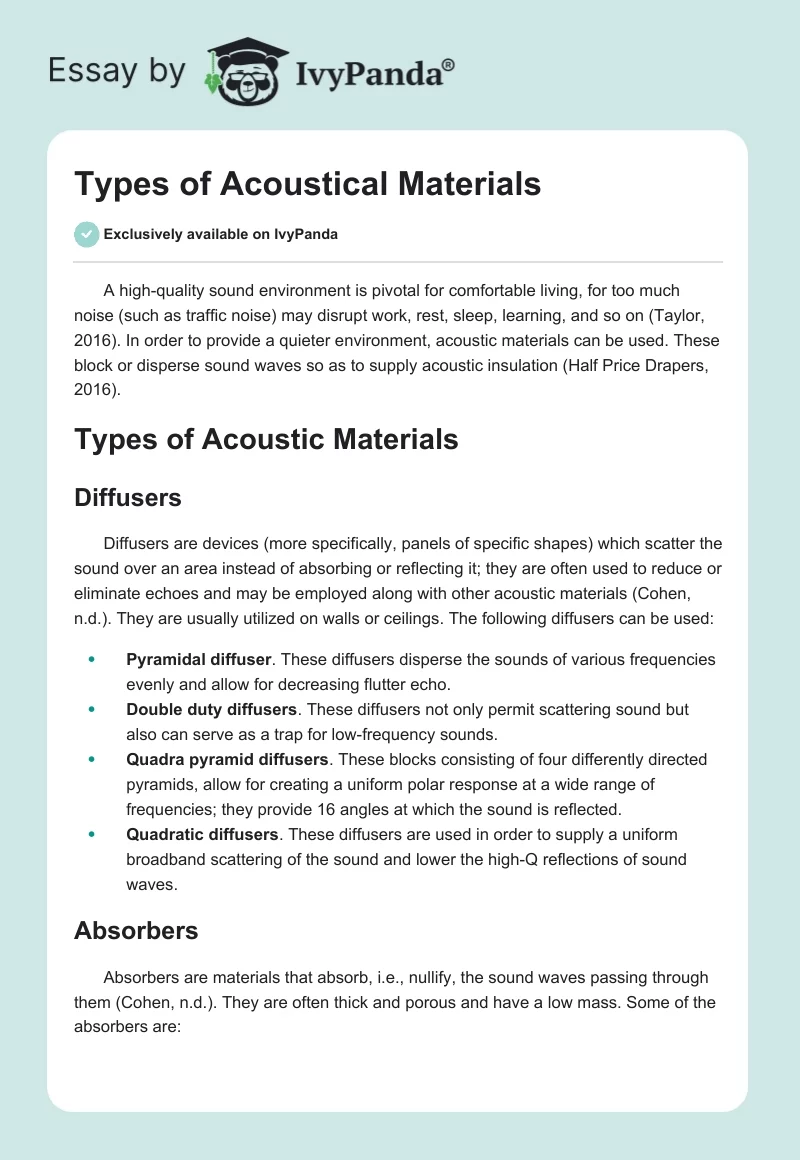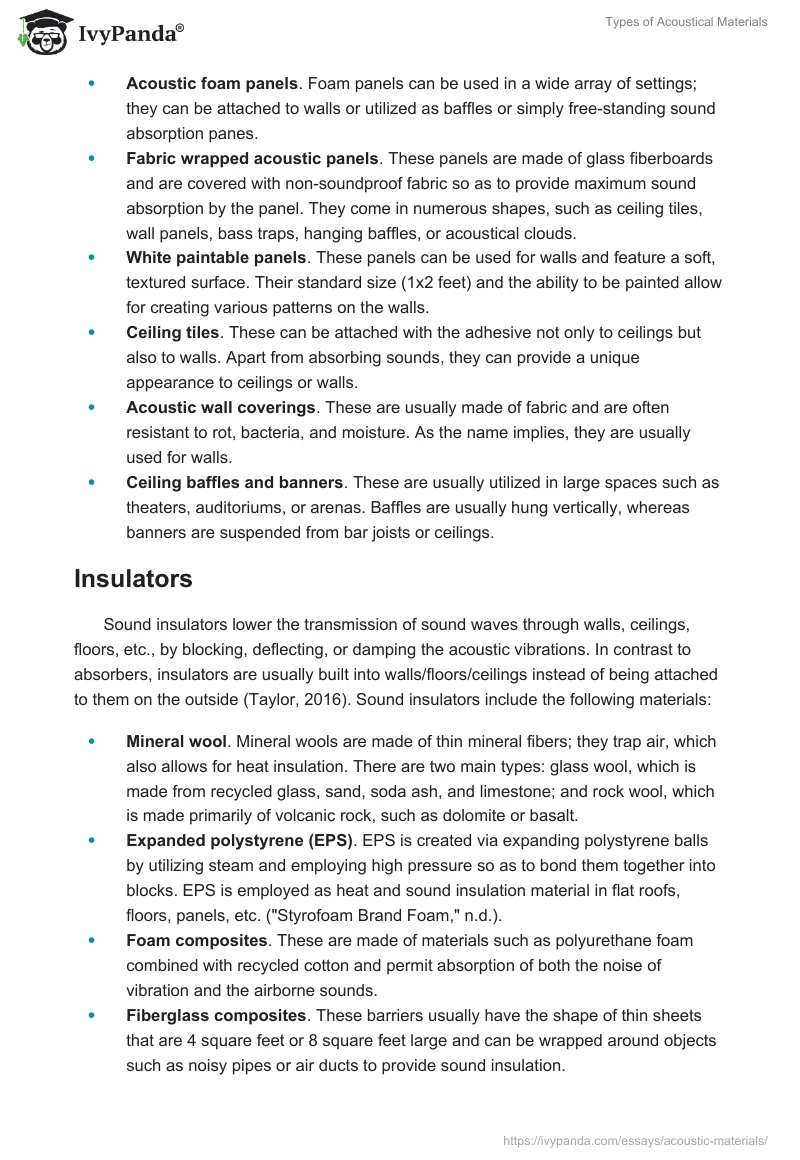A high-quality sound environment is pivotal for comfortable living, for too much noise (such as traffic noise) may disrupt work, rest, sleep, learning, and so on (Taylor, 2016). In order to provide a quieter environment, acoustic materials can be used. These block or disperse sound waves so as to supply acoustic insulation (Half Price Drapers, 2016).
Types of Acoustic Materials
Diffusers
Diffusers are devices (more specifically, panels of specific shapes) which scatter the sound over an area instead of absorbing or reflecting it; they are often used to reduce or eliminate echoes and may be employed along with other acoustic materials (Cohen, n.d.). They are usually utilized on walls or ceilings. The following diffusers can be used:
- Pyramidal diffuser. These diffusers disperse the sounds of various frequencies evenly and allow for decreasing flutter echo.
- Double duty diffusers. These diffusers not only permit scattering sound but also can serve as a trap for low-frequency sounds.
- Quadra pyramid diffusers. These blocks consisting of four differently directed pyramids, allow for creating a uniform polar response at a wide range of frequencies; they provide 16 angles at which the sound is reflected.
- Quadratic diffusers. These diffusers are used in order to supply a uniform broadband scattering of the sound and lower the high-Q reflections of sound waves.
Absorbers
Absorbers are materials that absorb, i.e., nullify, the sound waves passing through them (Cohen, n.d.). They are often thick and porous and have a low mass. Some of the absorbers are:
- Acoustic foam panels. Foam panels can be used in a wide array of settings; they can be attached to walls or utilized as baffles or simply free-standing sound absorption panes.
- Fabric wrapped acoustic panels. These panels are made of glass fiberboards and are covered with non-soundproof fabric so as to provide maximum sound absorption by the panel. They come in numerous shapes, such as ceiling tiles, wall panels, bass traps, hanging baffles, or acoustical clouds.
- White paintable panels. These panels can be used for walls and feature a soft, textured surface. Their standard size (1×2 feet) and the ability to be painted allow for creating various patterns on the walls.
- Ceiling tiles. These can be attached with the adhesive not only to ceilings but also to walls. Apart from absorbing sounds, they can provide a unique appearance to ceilings or walls.
- Acoustic wall coverings. These are usually made of fabric and are often resistant to rot, bacteria, and moisture. As the name implies, they are usually used for walls.
- Ceiling baffles and banners. These are usually utilized in large spaces such as theaters, auditoriums, or arenas. Baffles are usually hung vertically, whereas banners are suspended from bar joists or ceilings.
Insulators
Sound insulators lower the transmission of sound waves through walls, ceilings, floors, etc., by blocking, deflecting, or damping the acoustic vibrations. In contrast to absorbers, insulators are usually built into walls/floors/ceilings instead of being attached to them on the outside (Taylor, 2016). Sound insulators include the following materials:
- Mineral wool. Mineral wools are made of thin mineral fibers; they trap air, which also allows for heat insulation. There are two main types: glass wool, which is made from recycled glass, sand, soda ash, and limestone; and rock wool, which is made primarily of volcanic rock, such as dolomite or basalt.
- Expanded polystyrene (EPS). EPS is created via expanding polystyrene balls by utilizing steam and employing high pressure so as to bond them together into blocks. EPS is employed as heat and sound insulation material in flat roofs, floors, panels, etc. (“Styrofoam Brand Foam,” n.d.).
- Foam composites. These are made of materials such as polyurethane foam combined with recycled cotton and permit absorption of both the noise of vibration and the airborne sounds.
- Fiberglass composites. These barriers usually have the shape of thin sheets that are 4 square feet or 8 square feet large and can be wrapped around objects such as noisy pipes or air ducts to provide sound insulation.
- Quiet Batts. These are made out of cotton fibers and are quite simple to install. They provide high-quality sound and heat insulation and are used mainly for insulating walls (“Quiet Batt Soundproofing Insulation,” n.d.).
- Vinyl barriers. Vinyl barrier sheets are usually utilized with the purpose of blocking common noise such as the sound of conversations, stereo systems, or television. They can be employed inside walls, floors, or ceilings and are useful in a wide array of settings.
Results and Discussion
All in all, it was found out that there exist a variety of soundproof materials which can be utilized for various purposes. Some of them can be used in the process of building structures so as to serve as acoustic barriers inside walls; others are employed after a structure has been built by attaching them to a wall or a ceiling (Taylor, 2016).
It is interesting to observe that while some acoustic materials simply absorb sound waves, others (such as diffuser panels) reflect them, which may be used to create specific sound effects (e.g., in music concerts). It should be noted that panels, being sound reflectors, also serve as soundproofing, for the sound is, to a high degree, reflected from them, instead of passing through the wall or the ceiling.
Conclusion
On the whole, three main types of acoustic materials exist diffusers, absorbers, and insulators. Diffusers of various types are devices that are used to reflect sounds. In contrast, absorbers are materials that are soundproof and are mainly attached to the existing walls, ceilings, etc. Finally, insulators are manly materials that are used inside walls/floors/ceilings and often provide not only sound but also heat insulation.
References
Cohen, B. (n.d.). Types of acoustic materials. Web.
Half Price Drapes. (2016). The importance of acoustics in home and interior design [Blog post]. Web.
Quiet Batt soundproofing insulation. (n.d.). Web.
Styrofoam brand foam vs. expanded polystyrene (EPS).(n.d.). Web.
Taylor, C. (2016). Importance of interior for room acoustics – Getting your room to sound awesome. Web.


